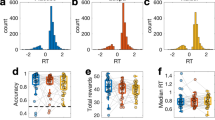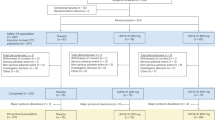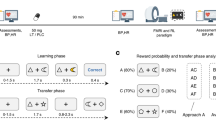Abstract
Long-term potentiation (LTP) of synaptic efficacy is considered a fundamental mechanism of learning and memory. At the cellular level a large body of evidence demonstrated that the major neuromodulatory neurotransmitters dopamine (DA), norepinephrine (NE), and acetylcholine (ACh) influence LTP magnitude. Noninvasive brain stimulation protocols provide the opportunity to study LTP-like plasticity at the systems level of human cortex. Here we applied paired associative stimulation (PAS) to induce LTP-like plasticity in the primary motor cortex of eight healthy subjects. In a double-blind, randomized, placebo-controlled, crossover design, the acute effects of a single oral dose of the neuromodulatory drugs cabergoline (DA agonist), haloperidol (DA antagonist), methylphenidate (indirect NE agonist), prazosine (NE antagonist), tacrine (ACh agonist), and biperiden (ACh antagonist) on PAS-induced LTP-like plasticity were examined. The antagonists haloperidol, prazosine, and biperiden depressed significantly the PAS-induced LTP-like plasticity observed under placebo, whereas the agonists cabergoline, methylphenidate, and tacrine had no effect. Findings demonstrate that antagonists in major neuromodulatory neurotransmitter systems suppress LTP-like plasticity at the systems level of human cortex, in accord with evidence of their modulating action of LTP at the cellular level. This provides further supportive evidence for the known detrimental effects of these drugs on LTP-dependent mechanisms such as learning and memory.
Similar content being viewed by others
Log in or create a free account to read this content
Gain free access to this article, as well as selected content from this journal and more on nature.com
or
References
Asanuma H, Pavlides C (1997). Neurobiological basis of motor learning in mammals. NeuroReport 8: i–vi.
Battaglia F, Wang HY, Ghilardi MF, Gashi E, Quartarone A, Friedman E et al (2007). Cortical plasticity in Alzheimer's disease in humans and rodents. Biol Psychiatry 62: 1405–1412.
Berends HI, Nijlant JM, Movig KL, Van Putten MJ, Jannink MJ, Ijzerman MJ (2009). The clinical use of drugs influencing neurotransmitters in the brain to promote motor recovery after stroke; a Cochrane systematic review. Eur J Phys Rehabil Med 45: 621–630.
Berthier ML, Pujol J, Gironell A, Kulisevsky J, Deus J, Hinojosa J et al (2003). Beneficial effect of donepezil on sensorimotor function after stroke. Am J Phys Med Rehabil 82: 725–729.
Bolden C, Cusack B, Richelson E (1992). Antagonism by antimuscarinic and neuroleptic compounds at the five cloned human muscarinic cholinergic receptors expressed in Chinese hamster ovary cells. J Pharmacol Exp Ther 260: 576–580.
Bröcher S, Artola A, Singer W (1992). Agonists of cholinergic and noradrenergic receptors facilitate synergistically the induction of long-term potentiation in slices of rat visual cortex. Brain Res 573: 27–36.
Bütefisch CM, Davis BC, Sawaki L, Waldvogel D, Classen J, Kopylev L et al (2002). Modulation of use-dependent plasticity by d-amphetamine. Ann Neurol 51: 59–68.
Calabresi P, Centonze D, Gubellini P, Bernardi G (1999). Activation of M1-like muscarinic receptors is required for the induction of corticostriatal LTP. Neuropharmacology 38: 323–326.
Castro-Alamancos MA, Donoghue JP, Connors BW (1995). Different forms of synaptic plasticity in somatosensory and motor areas of the neocortex. J Neurosci 15: 5324–5333.
Cohen BM, Lipinski JF (1986). In vivo potencies of antipsychotic drugs in blocking alpha 1 noradrenergic and dopamine D2 receptors: implications for drug mechanisms of action. Life Sci 39: 2571–2580.
Cohen J (1988). Statistical Power Analysis for the Behavioral Sciences. Lawrence Erlbaum Associates: Hillsdale.
Cooke SF, Bliss TV (2006). Plasticity in the human central nervous system. Brain 129: 1659–1673.
Crisostomo EA, Duncan PW, Propst M, Dawson DV, Davis JN (1988). Evidence that amphetamine with physical therapy promotes recovery of motor function in stroke patients. Ann Neurol 23: 94–97.
Di Lazzaro V, Dileone M, Pilato F, Profice P, Oliviero A, Mazzone P et al (2009). Associative motor cortex plasticity: direct evidence in humans. Cereb Cortex 19: 2326–2330.
Di Lazzaro V, Oliviero A, Profice P, Pennisi MA, Di Giovanni S, Zito G et al (2000). Muscarinic receptor blockade has differential effects on the excitability of intracortical circuits in human motor cortex. Exp Brain Res 135: 455–461.
Di Lazzaro V, Ziemann U, Lemon RN (2008). State of the art: physiology of transcranial motor cortex stimulation. Brain Stimul 1: 345–362.
Dommett EJ, Henderson EL, Westwell MS, Greenfield SA (2008). Methylphenidate amplifies long-term plasticity in the hippocampus via noradrenergic mechanisms. Learn Mem 15: 580–586.
Feldman DE (2009). Synaptic mechanisms for plasticity in neocortex. Annu Rev Neurosci 32: 33–55.
Flöel A, Breitenstein C, Hummel F, Celnik P, Gingert C, Sawaki L et al (2005a). Dopaminergic influences on formation of a motor memory. Ann Neurol 58: 121–130.
Flöel A, Hummel F, Breitenstein C, Knecht S, Cohen LG (2005b). Dopaminergic effects on encoding of a motor memory in chronic stroke. Neurology 65: 472–474.
Frantseva MV, Fitzgerald PB, Chen R, Moller B, Daigle M, Daskalakis ZJ (2008). Evidence for impaired long-term potentiation in schizophrenia and its relationship to motor skill leaning. Cereb Cortex 18: 990–996.
Geyer S, Ledberg A, Schleicher A, Kinomura S, Schormann T, Burgel U et al (1996). Two different areas within the primary motor cortex of man. Nature 382: 805–807.
Goldstein LB (1995). Common drugs may influence motor recovery after stroke. The Sygen In Acute Stroke Study Investigators. Neurology 45: 865–871.
Goldstein LB, Matchar DB, Morgenlander JC, Davis JN (1990). Influence of drugs on the recovery of sensorimotor function after stroke. J Neuro Rehab 4: 137–144.
Grade C, Redford B, Chrostowski J, Toussaint L, Blackwell B (1998). Methylphenidate in early poststroke recovery: a double-blind, placebo-controlled study. Arch Phys Med Rehabil 79: 1047–1050.
Gu Q (2002). Neuromodulatory transmitter systems in the cortex and their role in cortical plasticity. Neuroscience 111: 815–835.
Gu Q (2003). Contribution of acetylcholine to visual cortex plasticity. Neurobiol Learn Mem 80: 291–301.
Heidegger T, Krakow K, Ziemann U (2010). Effects of antiepileptic drugs on associative LTP-like plasticity in human motor cortex. Eur J Neurosci 32: 1215–1222.
Hess G, Donoghue JP (1999). Facilitation of long-term potentiation in layer II/III horizontal connections of rat motor cortex following layer I stimulation: route of effect and cholinergic contributions. Exp Brain Res 127: 279–290.
Huntley GW, Morrison JH, Prikhozhan A, Sealfon SC (1992). Localization of multiple dopamine receptor subtype mRNAs in human and monkey motor cortex and striatum. Brain Res Mol Brain Res 15: 181–188.
Ilic TV, Korchounov A, Ziemann U (2003). Methylphenydate facilitates and disinhibits the motor cortex in intact humans. NeuroReport 14: 773–776.
Ilyin VI, Whittemore ER, Guastella J, Weber E, Woodward RM (1996). Subtype-selective inhibition of N-methyl-D-aspartate receptors by haloperidol. Mol Pharmacol 50: 1541–1550.
Jackisch R, Forster S, Kammerer M, Rothmaier AK, Ehret A, Zentner J et al (2009). Inhibitory potency of choline esterase inhibitors on acetylcholine release and choline esterase activity in fresh specimens of human and rat neocortex. J Alzheimers Dis 16: 635–647.
Jung P, Ziemann U (2009). Homeostatic and non-homeostatic modulation of learning in human motor cortex. J Neurosci 29: 5597–5604.
Kang J-S, Terranova C, Hilker R, Quartarone A, Ziemann U (2011). Deficient homeostatic regulation of practice-dependent plasticity in writer's cramp. Cereb Cortex 21: 1203–1212.
Kosasa T, Kuriya Y, Matsui K, Yamanishi Y (2000). Inhibitory effect of orally administered donepezil hydrochloride (E2020), a novel treatment for Alzheimer's disease, on cholinesterase activity in rats. Eur J Pharmacol 389: 173–179.
Kőtter R, Stephan KE, Palomero-Gallagher N, Geyer S, Schleicher A, Zilles K (2001). Multimodal characterisation of cortical areas by multivariate analyses of receptor binding and connectivity data. Anat Embryol (Berl) 204: 333–350.
Kuczenski R, Segal DS (2001). Locomotor effects of acute and repeated threshold doses of amphetamine and methylphenidate: relative roles of dopamine and norepinephrine. J Pharmacol Exp Ther 296: 876–883.
Kuo M-F, Grosch J, Fregni F, Paulus W, Nitsche MA (2007). Focusing effect of acetylcholine on neuroplasticity in the human motor cortex. J Neurosci 27: 14442–14447.
Kuo M-F, Paulus W, Nitsche MA (2008). Boosting focally-induced brain plasticity by dopamine. Cereb Cortex 18: 648–651.
Lynch MA (2004). Long-term potentiation and memory. Physiol Rev 84: 87–136.
Marino MJ, Rouse ST, Levey AI, Potter LT, Conn PJ (1998). Activation of the genetically defined m1 muscarinic receptor potentiates N-methyl-D-aspartate (NMDA) receptor currents in hippocampal pyramidal cells. Proc Natl Acad Sci USA 95: 11465–11470.
Matsubara S, Matsubara R, Kusumi I, Koyama T, Yamashita I (1993). Dopamine D1, D2 and serotonin2 receptor occupation by typical and atypical antipsychotic drugs in vivo. J Pharmacol Exp Ther 265: 498–508.
Meintzschel F, Ziemann U (2006). Modification of practice-dependent plasticity in human motor cortex by neuromodulators. Cereb Cortex 16: 1106–1115.
Molina-Luna K, Pekanovic A, Rohrich S, Hertler B, Schubring-Giese M, Rioult-Pedotti MS et al (2009). Dopamine in motor cortex is necessary for skill learning and synaptic plasticity. PLoS One 4: e7082.
Monte-Silva K, Kuo M-F, Thirugnanasambandam N, Liebetanz D, Paulus W, Nitsche M (2009). Dose-dependent inverted U-shaped effect of dopamine (D2-like) receptor activation on focal and nonfocal plasticity in humans. J Neurosci 29: 6124–6131.
Morgante F, Espay AJ, Gunraj C, Lang AE, Chen R (2006). Motor cortex plasticity in Parkinson's disease and levodopa-induced dyskinesias. Brain 129: 1059–1069.
Müller-Dahlhaus F, Ziemann U, Classen J (2010). Plasticity resembling spike-timing dependent synaptic plasticity: the evidence in human cortex. Front Syn Neurosci 2: 1–11.
Müller-Dahlhaus JF, Orekhov Y, Liu Y, Ziemann U (2008). Interindividual variability and age-dependency of motor cortical plasticity induced by paired associative stimulation. Exp Brain Res 187: 467–475.
Müller JFM, Orekhov Y, Liu Y, Ziemann U (2007). Homeostatic plasticity in human motor cortex demonstrated by two consecutive sessions of paired associative stimulation. Eur J Neurosci 25: 3461–3468.
Nitsche MA, Kuo MF, Grosch J, Bergner C, Monte-Silva K, Paulus W (2009). D1-receptor impact on neuroplasticity in humans. J Neurosci 29: 2648–2653.
Nitsche MA, Roth A, Kuo M-F, Fischer AK, Liebetanz D, Lang N et al (2007). Timing-dependent modulation of associative plasticity by general network excitability in the human motor cortex. J Neurosci 27: 3807–3812.
Oldfield RC (1971). The assessment and analysis of handedness: the Edinburgh inventory. Neuropsychologia 9: 97–113.
Otani S, Daniel H, Roisin MP, Crepel F (2003). Dopaminergic modulation of long-term synaptic plasticity in rat prefrontal neurons. Cereb Cortex 13: 1251–1256.
Ovsepian SV, Anwyl R, Rowan MJ (2004). Endogenous acetylcholine lowers the threshold for long-term potentiation induction in the CA1 area through muscarinic receptor activation: in vivo study. Eur J Neurosci 20: 1267–1275.
Patel S, Fernandez-Garcia E, Hutson PH, Patel S (2001). An in vivo binding assay to determine central alpha(1)-adrenoceptor occupancy using [(3)H]prazosin. Brain Res Brain Res Protoc 8: 191–198.
Paulus W, Classen J, Cohen LG, Large CH, Di Lazzaro V, Nitsche M et al (2008). State of the art: pharmacologic effects on cortical excitability measures tested by transcranial magnetic stimulation. Brain Stimul 1: 151–163.
Philpot BD, Sekhar AK, Shouval HZ, Bear MF (2001). Visual experience and deprivation bidirectionally modify the composition and function of NMDA receptors in visual cortex. Neuron 29: 157–169.
Quartarone A, Bagnato S, Rizzo V, Siebner HR, Dattola V, Scalfari A et al (2003). Abnormal associative plasticity of the human motor cortex in writer's cramp. Brain 126: 2586–2596.
Quartarone A, Morgante F, Sant’angelo A, Rizzo V, Bagnato S, Terranova C et al (2008). Abnormal plasticity of sensorimotor circuits extends beyond the affected body part in focal dystonia. J Neurol Neurosurg Psychiatry 79: 985–990.
Richelson E, Souder T (2000). Binding of antipsychotic drugs to human brain receptors focus on newer generation compounds. Life Sci 68: 29–39.
Ridding MC, Ziemann U (2010). Determinants of the induction of cortical plasticity by non-invasive brain stimulation inn healthy subjects. J Physiol 588: 2291–2304.
Rosenkranz K, Kacar A, Rothwell JC (2007). Differential modulation of motor cortical plasticity and excitability in early and late phases of human motor learning. J Neurosci 27: 12058–12066.
Rösser N, Flöel A (2008). Pharmacological enhancement of motor recovery in subacute and chronic stroke. NeuroRehabilitation 23: 95–103.
Rossini PM, Berardelli A, Deuschl G, Hallett M, Maertens de Noordhout AM, Paulus W et al (1999). Applications of magnetic cortical stimulation. Electroencephalogr Clin Neurophysiol Suppl 52: 171–185.
Sanes JN, Donoghue JP (2000). Plasticity and primary motor cortex. Annu Rev Neurosci 23: 393–415.
Sawaki L, Boroojerdi B, Kaelin-Lang A, Burstein AH, Bütefisch CM, Kopylev L et al (2002). Cholinergic influences on use-dependent plasticity. J Neurophysiol 87: 166–171.
Sawaki L, Werhahn KJ, Barco R, Kopylev L, Cohen LG (2003). Effect of an alpha(1)-adrenergic blocker on plasticity elicited by motor training. Exp Brain Res 148: 504–508.
Scheidtmann K, Fries W, Muller F, Koenig E (2001). Effect of levodopa in combination with physiotherapy on functional motor recovery after stroke: a prospective, randomised, double-blind study. Lancet 358: 787–790.
Schwingenschuh P, Ruge D, Edwards MJ, Terranova C, Katschnig P, Carrillo F et al (2010). Distinguishing SWEDDs patients with asymmetric resting tremor from Parkinson's disease: a clinical and electrophysiological study. Mov Disord 25: 560–569.
Shim SS, Grant ER, Singh S, Gallagher MJ, Lynch DR (1999). Actions of butyrophenones and other antipsychotic agents at NMDA receptors: relationship with clinical effects and structural considerations. Neurochem Int 34: 167–175.
Stefan K, Kunesch E, Benecke R, Cohen LG, Classen J (2002). Mechanisms of enhancement of human motor cortex excitability induced by interventional paired associative stimulation. J Physiol 543: 699–708.
Stefan K, Kunesch E, Cohen LG, Benecke R, Classen J (2000). Induction of plasticity in the human motor cortex by paired associative stimulation. Brain 123: 572–584.
Stefan K, Wycislo M, Classen J (2004). Modulation of associative human motor cortical plasticity by attention. J Neurophysiol 92: 66–72.
Stefan K, Wycislo M, Gentner R, Schramm A, Naumann M, Reiners K et al (2006). Temporary occlusion of associative motor cortical plasticity by prior dynamic motor training. Cereb Cortex 16: 376–385.
Thickbroom GW (2007). Transcranial magnetic stimulation and synaptic plasticity: experimental framework and human models. Exp Brain Res 180: 583–593.
Thirugnanasambandam N, Grundey J, Adam K, Drees A, Skwirba AC, Lang N et al (2011). Nicotinergic impact on focal and non-focal neuroplasticity induced by non-invasive brain stimulation in non-smoking humans. Neuropsychopharmacology 36: 879–886.
Tokimura H, Di Lazzaro V, Tokimura Y, Oliviero A, Profice P, Insola A et al (2000). Short latency inhibition of human hand motor cortex by somatosensory input from the hand. J Physiol 523: 503–513.
Ueki Y, Mima T, Ali Kotb M, Sawada H, Saiki H, Ikeda A et al (2006). Altered plasticity of the human motor cortex in Parkinson's disease. Ann Neurol 59: 60–71.
Walker-Batson D, Smith P, Curtis S, Unwin H, Greenlee R (1995). Amphetamine paired with physical therapy accelerates motor recovery after stroke. Further evidence. Stroke 26: 2254–2259.
Weise D, Schramm A, Stefan K, Wolters A, Reiners K, Naumann M et al (2006). The two sides of associative plasticity in writer's cramp. Brain 129: 2709–2721.
Wolters A, Sandbrink F, Schlottmann A, Kunesch E, Stefan K, Cohen LG et al (2003). A temporally asymmetric Hebbian rule governing plasticity in the human motor cortex. J Neurophysiol 89: 2339–2345.
Ziemann U (2004). TMS and drugs. Clin Neurophysiol 115: 1717–1729.
Ziemann U, Ilic TV, Pauli C, Meintzschel F, Ruge D (2004). Learning modifies subsequent induction of LTP-like and LTD-like plasticity in human motor cortex. J Neurosci 24: 1666–1672.
Ziemann U, Meintzschel F, Korchounov A, Ilic TV (2006). Pharmacological modulation of plasticity in the human motor cortex. Neurorehabil Neural Repair 20: 243–251.
Ziemann U, Paulus W, Nitsche MA, Pascual-Leone A, Byblow WD, Berardelli A et al (2008). Consensus: motor cortex plasticity protocols. Brain Stimul 1: 164–182.
Zittel S, Weiller C, Liepert J (2007). Reboxetine improves motor function in chronic stroke: a pilot study. J Neurol 254: 197–201.
Acknowledgements
We thank Dr Tihomir Ilic for help with some of the experiments.
Author information
Authors and Affiliations
Corresponding author
Ethics declarations
Competing interests
The authors declare that this study was supported by grant DFG ZI 542/4-1 (to UZ) from the German Research Foundation. UZ has received a grant from the Federal State of Hesse, and honoraria for editorial work from Brain Stimulation (Elsevier), and for scientific presentations from GlaxoSmithKline and Biogen Idec.
Rights and permissions
About this article
Cite this article
Korchounov, A., Ziemann, U. Neuromodulatory Neurotransmitters Influence LTP-Like Plasticity in Human Cortex: A Pharmaco-TMS Study. Neuropsychopharmacol 36, 1894–1902 (2011). https://doi.org/10.1038/npp.2011.75
Received:
Revised:
Accepted:
Published:
Issue date:
DOI: https://doi.org/10.1038/npp.2011.75
Keywords
This article is cited by
-
Underlying mechanisms of long-term potentiation during the inhibition of the cannabinoid CB1 and GABAB receptors in the dentate gyrus of hippocampus
BMC Neuroscience (2023)
-
Assessing the mechanisms of brain plasticity by transcranial magnetic stimulation
Neuropsychopharmacology (2023)
-
Gradual enhancement of corticomotor excitability during cortico-cortical paired associative stimulation
Scientific Reports (2022)
-
Motor-cortex excitability and response variability following paired-associative stimulation: a proof-of-concept study comparing individualized and fixed inter-stimulus intervals
Experimental Brain Research (2019)
-
Pharmacological Manipulation of Cortical Inhibition in the Dorsolateral Prefrontal Cortex
Neuropsychopharmacology (2018)



